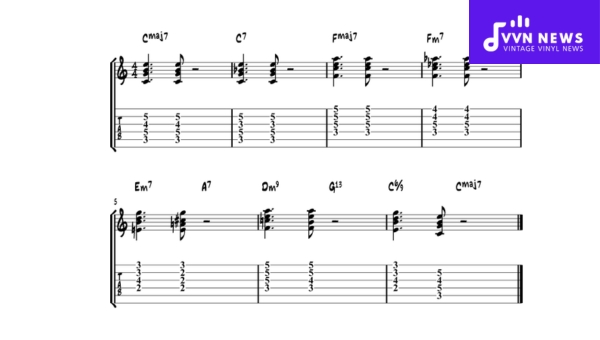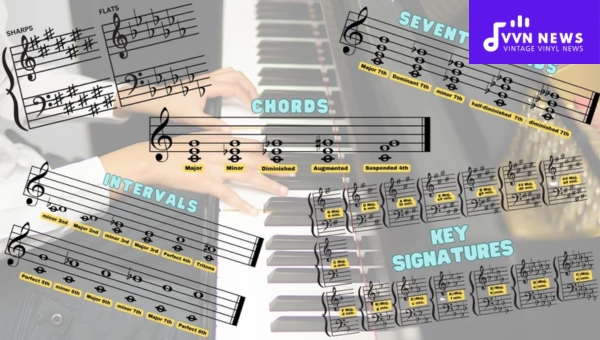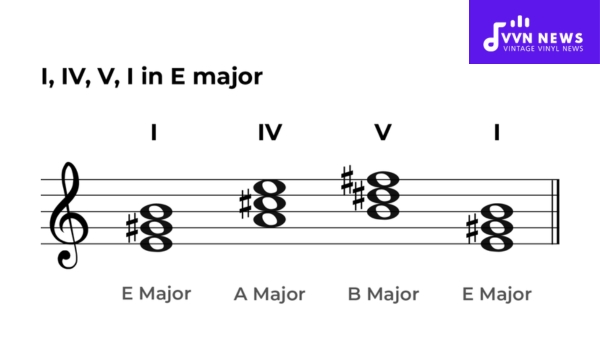Popular chord progressions are essential for musicians and songwriters of all levels.
Music, at its core, is a language, and just like with any language, there are certain ‘phrases’ that appear more regularly than others.
I like to think of these phrases or sequences as the popular chord progressions in music.
If you take a few minutes to familiarize yourself with them, you’ll find that they can help you listen to music more intelligently and even inspire new songwriting ideas.
Knowing your chord progressions can be the difference between feeling lost in a sea of chords and feeling at peace with your musical direction.
What is a Chord Progression?
A chord progression is a sequence of chords played in a set pattern. In music, this structured approach to chord sequences creates the harmonic foundation of a song.
Progressions guide the flow of music from one chord to the next, shaping its emotional impact and narrative drive.
It’s the comforting cycle of a common pop sequence or the tense shift in a jazz improvisation, these progressions are pivotal in evoking specific moods and providing a backbone for melodies and rhythms.
Recognizing these patterns can greatly enhance your musical literacy and compositional prowess.
Also Read: Phrygian Mode [Adding Exotic Flair To Your Musical Compositions]
Different Types of Chord Progressions
When diving into the realm of music composition and songwriting, you’ll quickly realize that some chord progressions tend to recur across various genres.

These sequences of chords form the backbone of many iconic songs. Let’s explore some of these popular chord progressions and dissect their roles in creating memorable melodies and harmonies.
I-IV-V-I Progression
Often heralded as the classic progression, I-IV-V-I is a staple in Western music, especially dominant in pop, rock, blues, and country.
This sequence moves from the tonic (I) to subdominant (IV), to dominant (V), and resolves back to the tonic (I).
The sense of finality when returning to the tonic makes it a go-to ending for many songs.
The 12-Bar Blues
Rooted deeply in African-American history, the 12-bar blues progression is a framework for an entire genre – blues music.
It has a defined pattern over twelve bars usually involving the I7, IV7, and V7 chords.
The cyclical nature gives it an inherent groove that has seeped into jazz and rock ‘n’ roll.
I-V-vi-IV Progression
This progression moves through several moods — from confident to nostalgic — making it perfect for storytelling in songs.
The movement from V to vi introduces a poignant minor tone before resolving back with IV and is found across countless hits.
ii-V-I Progression
A cornerstone in jazz music; this ii-V-I progression forms the harmonic base for many standards.
Musicians often embellish each chord with extensions and alterations but the underlying movement remains foundational within jazz circles.
The Canon Progression (I-V-vi-iii-IV-I-IV-V)
Also known as Pachelbel’s progression, due to its feature in Pachelbel’s “Canon.” This sequence flows with an undulating feel; creating ascending tension that cycles harmoniously.
I – vi – IV – V
This is another timeless progression with roots in doo-wop music but expanding far beyond into modern ballads and pop songs.
It conveys a strong emotional narrative that listeners find comforting yet engaging.
I – IV – V – IV
You’ll notice this loop often in upbeat rock or country tunes where there’s a constant toggle between contentment (I) and aspiration or drive (V).
vi – IV – I – V
Popularized by contemporary pop songs, this progression reflects emotions transitioning from introspective moments (*vi*) to triumphant declarations (*V*).
I – IV – ii – V
Intriguingly subtle with its inclusion of ii right before moving back into V, providing a soft lead-in back to either repose on the tonic or continue cycling through other chords.
I – IV – I – V
Perhaps one of the most simple yet satisfying progressions; its symmetry brings musical statements full circle without complication or excessive frills.
I–ii–iii–IV–V
Less common than others but noteworthy for its step-by-step ascension adds movement while maintaining diatonic harmony within a key signifying growth in tunes.
I – III – IV – iv
A mixture of major (III) and minor (iv) chords injects complex emotions; switching from powerful statements to vulnerable admissions within a single chord shift.
All these progressions lay down shared paths composers can wander along while infusing their unique twists along the way.
By experimenting with these core sequences musicians craft distinct moments that resonate through time — echoes familiar yet eternally fresh.
Also Read: How To Transpose Music? [Simplifying Key Changes In Songs]
How Ear Training Can Help in Recognizing Chords?
Ear training is akin to lifting weights for your listening skills. It sharpens your ability to distinguish between different harmonic structures and can be pivotal in identifying chord progressions. Here are the crucial points:
- Enhances Musical Perception: Through consistent practice, you develop a refined auditory perception, allowing you to pick out individual chords and their qualities (major, minor, diminished, etc.) with greater ease.
- Facilitates Transcription: With a trained ear, transcribing songs becomes less daunting. You’ll be able to hear a song and notate the chords without solely relying on sheet music or tabs.
- Improves Improvisation: Knowing how chords sound helps you anticipate musical structures and confidently improvise over them.
- Develop Internal Pitch Reference: Over time, you may develop relative pitch—the ability to determine pitches about known pitches. This skill is invaluable in identifying chord relationships.
- Encourages Creative Songwriting: Recognizing common progressions can inspire variations and novel takes on traditional sequences for your compositions.
Ear training is not just about recognizing chords; it’s also about building a more intimate relationship with music itself.
As you train your ear, the connection between what you hear and what you play or write becomes more instinctual.
How Can Songs Sound Different with the Same Chord Progression?
You might be surprised to learn that a variety of songs across multiple genres often share the same chord progression.

These tunes can sound completely distinct from one another. The secret lies not merely in the chords themselves but in how they’re arranged and executed.
Let’s delve into some of the factors that contribute to this musical diversity.
Instrumentation
Instrumentation plays a pivotal role. The choice of instruments can color the chord progression in unique ways.
A simple C-G-Am-F sequence will carry a different vibe on a classical piano compared to jangling electric guitars or a ukulele.
Rhythm and Tempo
The rhythm and tempo at which chords are played also factor greatly into their distinctive sound.
A progression hustled through at a quick pace lends itself to an upbeat pop song, while taking it slow may steer it into ballad territory.
Arrangement and Voicing
Another key element is arrangement and voicing. Chords can be rearranged by changing the order of notes (voicing) or emphasizing different notes within the chord (emphasis).
This subtle tweak alone can endow a familiar progression with a fresh life.
Melody and Harmonics
The melody layered over the top of a chord progression defines much of a song’s character—alter it, and you change its personality.
Meanwhile, harmonics—the overtones produced alongside the primary note—can provide added texture and depth.
By mixing these variables—alongside effects like reverb or distortion—you’re equipped with an expansive toolkit to make even the most common chord progressions unrecognizable from one piece to the next.
It’s this creative flexibility that helps artists take universal sequences and stamp them with their signature style.
Also Read: A Flat Diminished Triad [Delve Into Rare Guitar Chords]
Songs that feature different chord progressions
Music aficionados often marvel at how diverse songs employ unique chord progressions to evoke a vast array of emotions.
Within the tapestry of modern music, certain songs have become emblematic of these patterns.
I-IV-V Progression
A staple in blues, rock, and country, the I-IV-V progression is beautifully exemplified by the timeless track “Twist and Shout,” originally recorded by The Top Notes but most famously covered by The Beatles.
The driving simplicity of its chords—rooted in the key of D as D-G-A—lends it an infectious quality.
ii-V-I Progression
Jazz standards frequently make use of the smooth-sailing ii-V-I sequence. Billie Holiday’s rendition of “All Of Me,” swings through a cycle that typically begins with a minor ii chord, moves to a dominant V and resolves on a major I. This progression stands at the heart of many jazz compositions.
I-V-vi-IV Progression
Modern pop has seen the I-V-vi-IV combination become nearly ubiquitous.
This sequence lays down an emotional foundation in Journey’s “Don’t Stop Believin'”, where E-B-C#m-A chords in the key of E provide stirring momentum throughout this anthemic tune.
Each song mentioned showcases disparate emotional landscapes woven through their distinct chord sequences.
While exploring these tracks, listeners can appreciate not only their melodic appeal but also how each progression shapes musical storytelling.
FAQs About Popular Chord Progressions
What are chord progressions exactly?
Chord progressions are sequences of chords that are used to harmonize music and provide the background for melodies.
Can the same chord progression be used in different genres?
Yes, the same chord progression can stretch across many genres, taking on a unique sound depending on the style.
Is there a most popular chord progression in modern pop music?
The I-V-vi-IV progression is incredibly popular in modern pop, known for its catchy and emotional harmonic flow.
Do all songs have a chord progression?
Nearly all songs use some type of chord progression, though they can vary widely in complexity and style.
How important is it to learn about chord progressions for songwriting?
Mastering chord progressions is crucial for crafting well-structured and engaging songs.
Also Read: F Sharp Major Triad [Enhance Your Musical Compositions]
Conclusion
Mastering popular chord progressions is pivotal for enhancing your musical toolkit. If you’re dissecting your favorite tunes or weaving your original melodies, these progressions are the golden threads in the rich tapestry of music.
There’s beauty in realizing how a simple I-IV-V can be a unifying thread across genres, or how a ii-V-I can set a jazzy tone.
Dive into practice, train your ear, and above all, experiment with these structures to discover your unique sound. It’s remarkable how such foundational sequences can be infinitely innovative when filtered through your creativity.








